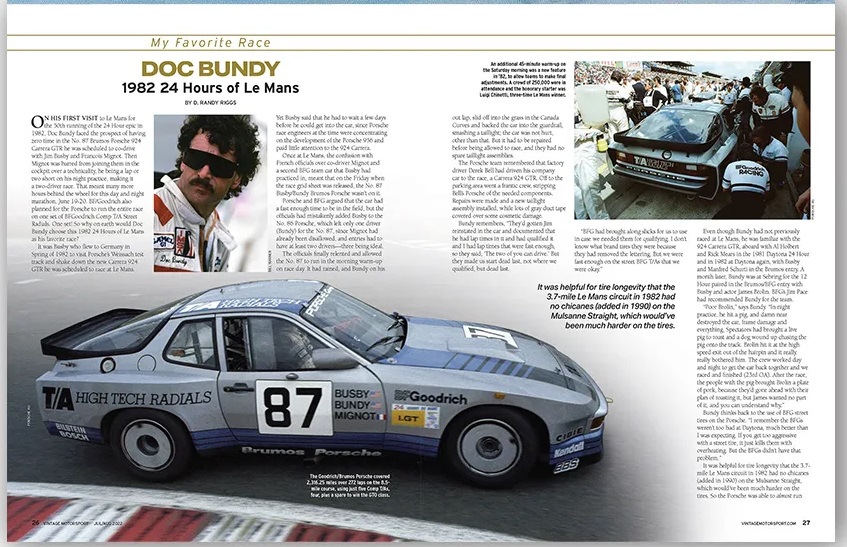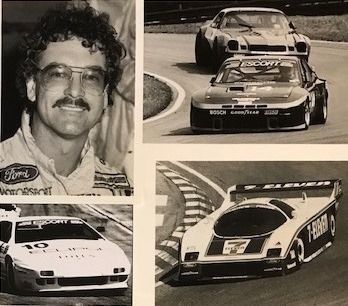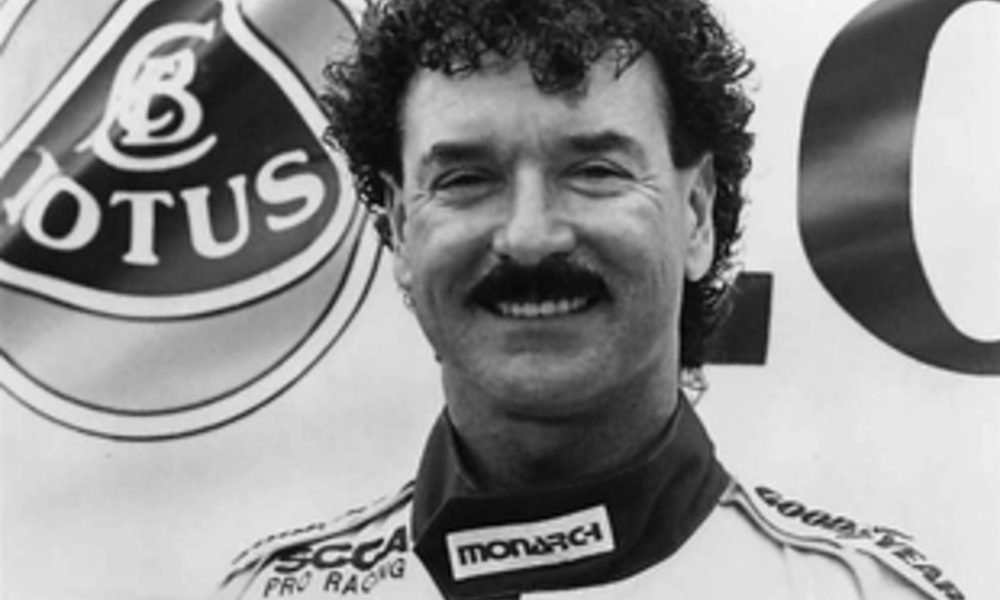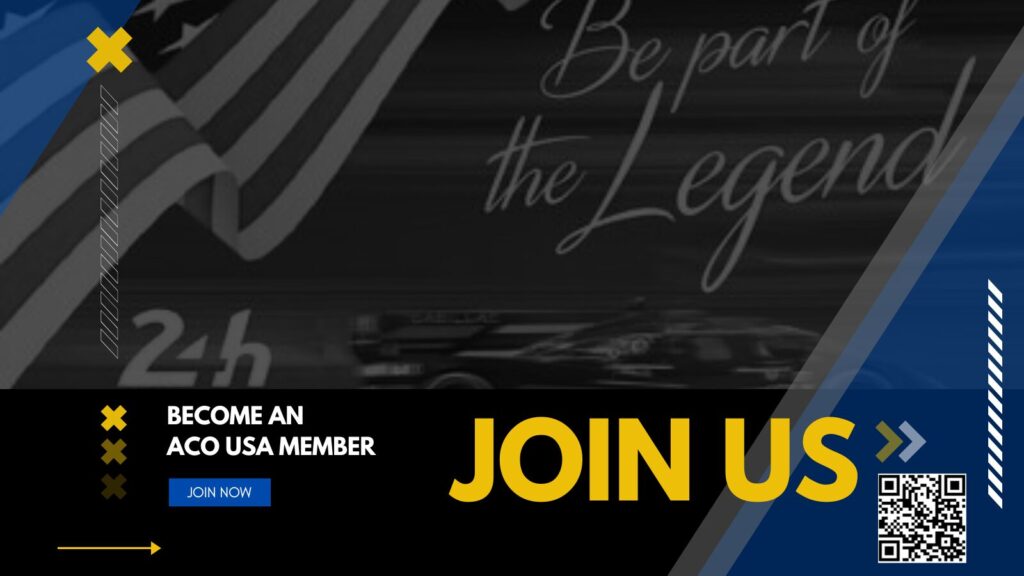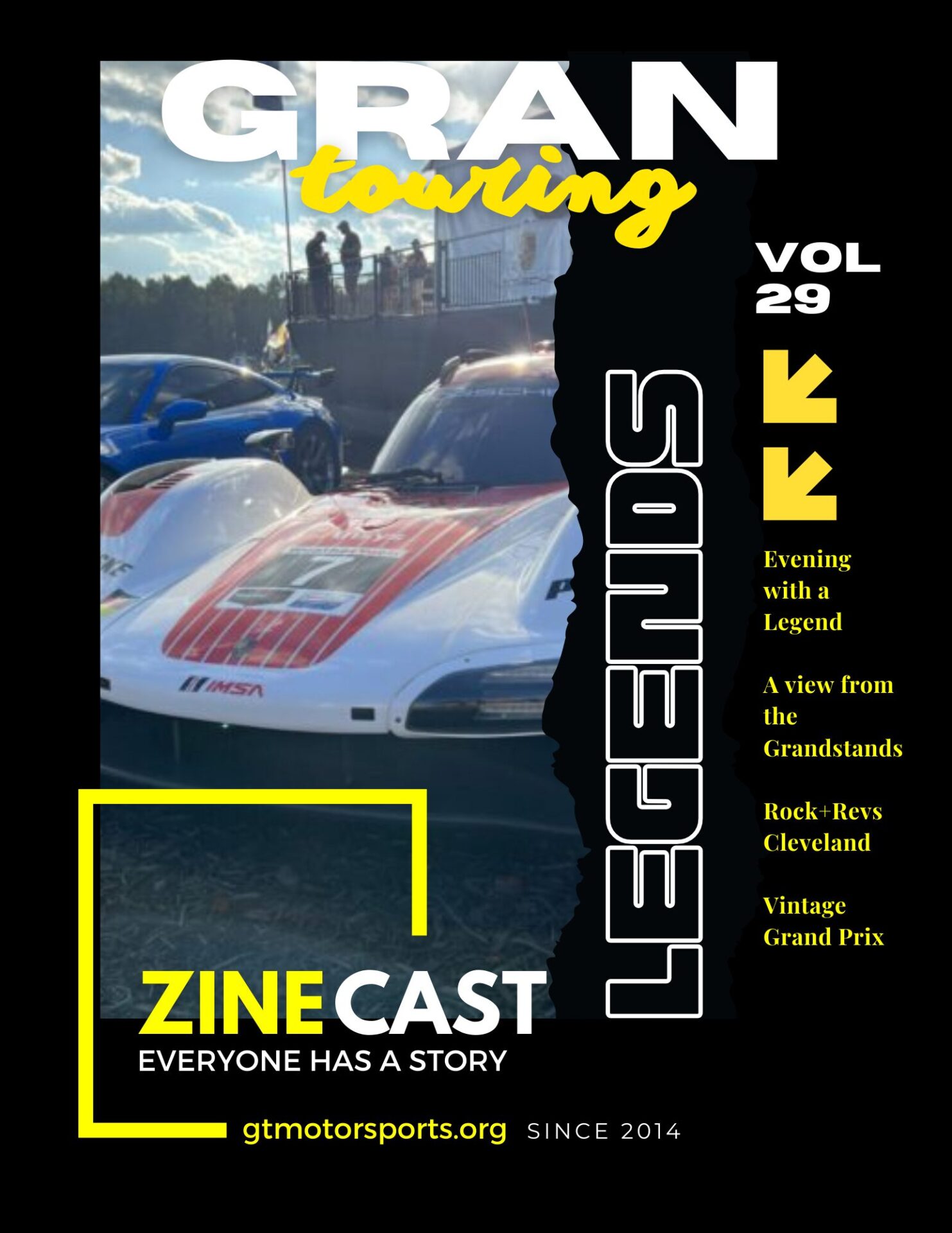Doc Bundy‘s motorsports career began as a wheel polisher and technician for Porsche driver Peter Gregg in 1973. The following year, he moved to Al Holbert Racing, where he spent the next five years preparing cars. In 1980, Bundy began driving for Holbert Racing in a Porsche 924, capturing a National Championship as a rookie.
He followed that by driving a Porsche 924 Turbo and took a class win in the GTO Category at the 24 Hours of Le Mans. Over the next few years, he would drive for Lotus, Jaguar, Ford, and Chevrolet (Corvette), topped with a season racing a Porsche 962.
Bundy shared driving duties in the Hendrick Motorsports IMSA Chevrolet Corvette GTP with Sarel Van Der Merwe from 1986 through the 1988 season when Hendrick abandoned the Corvette project. He was involved in a serious crash with Lyn St. James and Chip Robinson at the 1986 Riverside Grand Prix.
Tune in everywhere you stream, download or listen!
 |  |  |
- Spotlight
- Notes
- Transcript
- Highlights
- Learn More
Spotlight
Doc Bundy - Professional Race Car Driver for
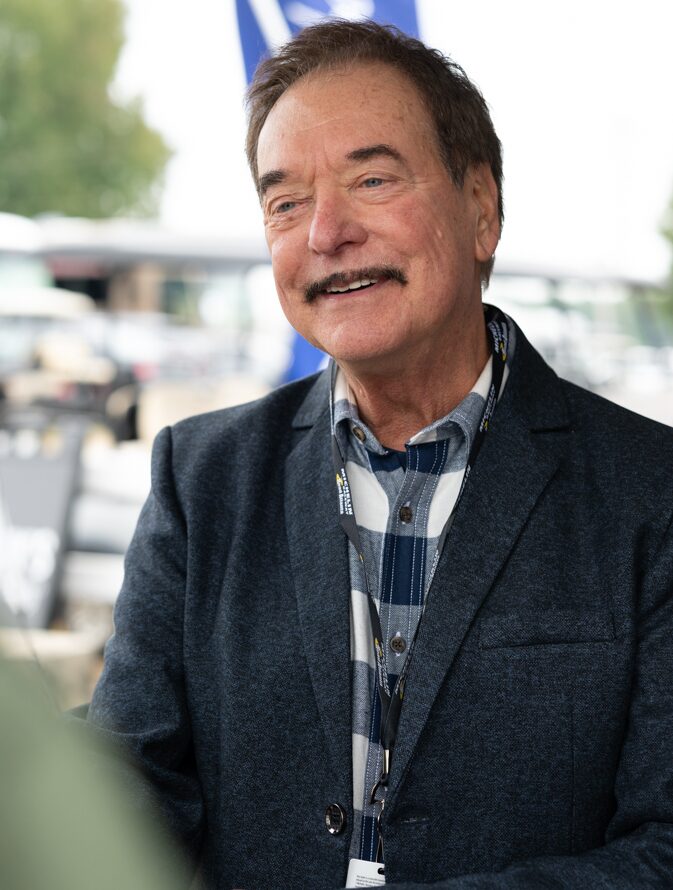
Harry "Doc" Bundy (born January 25, 1946) from Scio, Ohio, is an American former race car driver who competed in IMSA (International Motor Sports Association), 24 Hours of Le Mans, NASCAR Rolex Grand-Am Sports Car Series, American Le Mans Series, USRRC, and SCCA World Challenge.
Contact: Doc Bundy at Visit Online!![]()
Notes
- This Evening With A Legend was hosted by David Spitzer from the ACO USA.
and much, much more!
Transcript
Crew Chief Brad: [00:00:00] Evening with the Legend is a series of presentations exclusive to Legends of the Famous 24 Hours of Le Mans, giving us an opportunity to bring a piece of Le Mans to you. By sharing stories and highlights of the big event, you get a chance to become part of the Legend of Le Mans, with guests from different eras of over 100 years of racing.
Crew Chief Eric: Doc Bundy is a renowned figure in motorsports and has left an indelible mark on the iconic 24 Hours of Le Mans throughout his career. His journey at Le Mans also spans multiple years in teams, each marked by displays of exceptional skill, determination, and sportsmanship. Doc’s driving record reflects a remarkable consistency and competitiveness on the legendary circuit, where he has navigated the grueling endurance race with precision and flair.
Whether piloting prototypes or GT [00:01:00] cars, Doc’s performances have often been characterized by a blend of speed, strategy, and resilience, earning him admiration from fans and fellow competitors alike. This Evening with a Legend was hosted by David Spitzer, a member of the ACO USA, and who you might recognize as one of the pit reporters from the 24 Hours of Le Mans.
David Spitzer: Welcome to all of our guests this evening from the ACO club. We’re excited to host another of our theories all about an evening chat with racing legend. And tonight we are very honored and very excited to speak to doc Bundy with a wonderful history and Porsche’s and racing many years spent with Al Holbert and that legendary team and driving for a number of different manufacturers, but without further ado, let me introduce doc.
Hello y’all. So doc, I’m going to kind of get you started and I know because you and I had a great chat recently that once we get you going, the wonderful stories will flow. Do you want to start with a little bit about how you got into racing, but make sure you work us up to [00:02:00] Lamar and a little bit of how you got to Lamar, but go ahead.
Tell us a little bit about getting into racing and the early part of your
Doc Bundy: career. Like most karts as a youngster. I grew up in a very tiny little town. They used to tell me when I was little that it was 2, 000 people, but I think they counted all the farms and all the farm animals in that number, because I think realistically it was maybe 600 people or something like that.
I became a paper boy there, took over from another guy that got older and so he was ready to quit and hand it down. He delivered five different newspapers and two Sunday papers. So I increased it to seven daily papers, seven from different towns and three Sunday papers. So as you can imagine, I start out with a bicycle with baskets and I would have to go back to the drugstore and pick up more papers because I couldn’t carry all that [00:03:00] I needed to deliver to the whole town.
I had a moped for a while. After the moped, I had a bicycle. Bad rep. I ran out of paper about a mile out of town. So I got to go back to the goat store and get it real quick. So I’m flying back 35 40 mile an hour on the moped and the town was in a valley that had two sets of railroad tracks. with a creek between them that you crossed.
As a young boy, I had a friend on the other side of town. Two of us rode our bicycles to meet up with him and he went around the crossing gate and the train hit him.
David Spitzer: Oh goodness.
Doc Bundy: Oh yeah.
David Spitzer: Now you got to help us get back to racing. Come on, how does this get us to racing? Were you making money with your paper route and that got you to get a go kart?
Doc Bundy: What happened was, I was on a Saturday, I was collecting. At this time, I had a yard cart with a Clinton engine on it, and I fiddled around with it a little bit to try to make it a little bit faster. When I was [00:04:00] on one side of town, I heard this noise that sounded like my engine with no muffler. I worked my way down, customer wise, to the ballpark, and here was two go karts running there.
Real go karts. Not yard carts. Proper go carts. Yeah. And so I ride up these two guys and they were just riding down there at the park with ball field from another town. They’d come over trying to get kids or people to show up because they wanted to sell them. I couldn’t wait to get done. So they let me drive it.
I thought, Oh, this is the real thing. And I have grown up. My father taking me to race. Where was that now? What track? Would we know it? They were okay. As soon as I got home, you know, I grabbed my dad and I said, Dad, you got to see these things. These are amazing. He was a race fan. So he got into it. He got along with some other fathers and they, in the end, they built a racetrack.
Oh, wow. We started out down there beyond the [00:05:00] ballpark on a dirt track. Oh, that lasted not too long floods and things kind of ruined it. They ended up making a paved track and I was part of the building process. That’s when I learned to drive a pickup truck. And so we raced go karts till I was probably a senior.
Then I went off to a school in Minneapolis and went to work for an airline in Chicago. The weirdest thing is my ideal race car. Post Vietnam, a Formula B car, which morphed into a Formula Atlantic eventually, that was my dream car. I just had to have one of those. I never had one. I never got to drive one.
David Spitzer: That was the goal to get to that level of pace, that level of power and everything else, right?
Doc Bundy: Yeah. I had a friend that we went together and bought a Lotus 22 Formula C car, 1100 cc engine. That didn’t last very long. Got crashed. Wasn’t my crash. Driven [00:06:00] up to Watkins Glen to do a regional, forgot to charge the battery.
So I was out first practice and a guy spun in front of me and so I had to spin to miss him. Going into turn one, so I went off on the outside and it wouldn’t restart. Battery was dead. They wouldn’t let me move the car. And of course, I got hit. We almost got into a fight. This is not worth your life. It is fine.
It’s everything I have is invested in this thing. There’s a waving yellow. There’s no problem. All the cars have gone by. They’ve seen it. You were in the strike zone. Yep. And I saw this car coming and I could see his eyes and he was staring at my race car and I thought, no, no, no, no, don’t look at it.
Because your hands follow your up. So sure enough, he realized the last second that he was going to hit it, and he blocked up, went into the side of it, bent the chassis. So I had no clue how to fix that.
David Spitzer: So if we go on Wikipedia, this made you chuckle because I shared with you what it says on Wikipedia about you.
It [00:07:00] says you started out, I thought it said mechanic, but it says car prep. Tell us a little bit about the early days with Peter Gregg, the legend from the Brumos organization. Give us a few minutes of what it took to get into your first Porsche race car.
Doc Bundy: From that experience, God knows how I ever convinced him to even take my phone calls, but I started calling John Bishop.
I’m trying to talk him into taking Making formula be part of it was new to talk. And so that was my goal. And I call him all the calls.
David Spitzer: I don’t know. Bless that man. Everybody talks about him being a saint. Now I’ve got more evidence. It
Doc Bundy: was when Peg would answer. Usually Peg would answer, but sometimes he would.
And she would say, Okay, Doc, just a minute. I’ll get John. And he would take the call. So, and eventually what he did is he said, Doc, he says, you’ve got great ideas, very enthusiastic, and you need to Get experience. You need real world experience. You need to [00:08:00] go work for a race team. So after the crash of my car, I didn’t have a choice.
Quit the airline, called Peter Gregg out of the blue. I picked him because I wanted to be in EMSA. To me, it was either or. Roger Penske, but I was afraid of Roger Penske because he looked too military oriented, and I’d come out of the military. I didn’t want to stay in there. Or Roy Woods, because he ran 5, 000 Trans Am in Canada, which was great racing, but I wanted to be in EMSA.
I saw an ad that said that Peter, Greg was looking for people, a gopher. I called Peter, he said, well, if you’ll come down here to Jacksonville, I was up in Ohio at that time. If you’ll come down here to Jacksonville, he says, I’ve got about seven of you guys I’m gonna try out. And he says, whoever works the best, that’s who I’m gonna hire.
Well, that was simple to me. ’cause you know, I’m a returning vet. I could outwork anybody, so I didn’t have anything. I go down there. Get to the [00:09:00] shop. They’re getting ready for Sebring and they’d already won the 24. So I lived in the race shop for a couple of weeks and then we went to Sebring and we won there.
He sold that car and we’ve got another new car. for the next event, which was back then Road Atlanta. We went there, we won there. So we won four races in a row. Now, he hadn’t hired me officially, but after each race, because he won or sat on the pole one or the other, he gave us each a hundred dollars. I had some to live on.
When I came back, I couldn’t keep living in the race shop. One of the other guys that got hired, his dad was the sheriff of Ruvala County, which is the whole city. And his mother was a doctor. Later on, he becomes a FBI agent. So that’s how I started with Peter. I just outworked everybody. And I would stay in the shop.
There was a little [00:10:00] MG dealership in front of
the
Doc Bundy: warehouse where the race shop was. I would go over there because they had a shower and I could shower and that
David Spitzer: story though is everybody in racing. I mean, everybody’s got to make a sacrifice. You’ve got to have that journey to really value it. So you spend some time taking care of the motor home for them and kind of working your way into things.
How many years of hard work was it before you started driving? And then how many years of driving before you were graced with the opportunity to run at Le Mans?
Doc Bundy: I was two years with Peter and realized there was no future for what I wanted. About the early fall of the second year, I went to Peter and I said, look, I’m going to leave at the end of the season.
He said, where are you going to go? And I, Oh, I’m looking for, Someplace where I might have an opportunity to drive at some point and he goes, it’s never going to happen. He says, I’ve met your family. They have no money. Who’s going to give you a 50, [00:11:00] 000 race car to learn to drive? And I go, I know how to race like that.
But his telling me no, no, no, just motivated me. That much more, I was determined and along that period, I had met Al Holberg, he had an engine, a three liter that Peter bought from him. So I got sent to get the engine. I already had met Al and had talked with him and that sort of thing. So I went up there to get the engine and he just kept delaying, delaying, delaying, delaying, giving it to me.
And so finally I sat down with Al and he said, What’s your big hurry to go back? It was on a weekend. I’d driven up Friday, and then I had the weekend off, and then back to work on Monday. He wanted me to stay and chat with him, because we talk racing, much to the chagrin of his wife. So Al said, why don’t you come to work for me?
And I go, well, no, I’m committed to Peter for the balance of this year. I said, [00:12:00] besides Al, what I want to do is drive eventually. You know, I made it clear up front, and he said, okay. I said, we’re about the same age, and you have all this experience, and you are really good. I could never drive with you because I have to go through the learning phases.
He eventually convinced me, because I finished with Peter at the Christmas party, actually got a handwritten letter of recommendation. Anytime you ever want to come back, we’ll welcome you. And I said, well, I hope I won’t be back, unless you’re hiring me as a driver. And he laughed, and we parted on friendly terms.
I didn’t want to go to work for Al because I just didn’t think I would have a future there. Didn’t feel like I had a lot to offer, but he kept calling, how would you view this happening? How do you view that you could get to drive? And I said, well, I have some ideas about sponsorship and I’ll search out sponsorship.
I can help on [00:13:00] the race car, but I’m not going to be a mechanic. Brumos tried to make me a mechanic. I didn’t want to be one. I learned to do things. I disassembled a 917 engine cannon with the real mechanic. He made me take everything apart. And I said, how are we ever going to get it back together? He just laughed.
He says, I’ll put it together. Don’t worry. I just knew enough and could do enough to understand mechanics. You know, I knew the cars because I would turn just enough wrenches To learn the cars. Eventually, Al convinced me to come to work for him. That next year, still living in Jacksonville, he had me come down to Daytona and he says, we’ll move you to Pennsylvania after the race.
We did pretty good in the race. I don’t remember where we finished that first year, but we were in contention through a lot of the race. And I think it had some kind of a problem that we lost time. And then we get up to Pennsylvania. He moves me in the house with him, his wife and two children. I was there for probably about [00:14:00] two months, finally got a place of my own.
In the meantime I started learning how to promote Al. He didn’t have much of a reputation then, other than he was Bob Holbrook’s son. His father was a banker. pretty successful racer. Father was a wonderful guy, but Al, you know, like most sons and dads, the two of them didn’t always get along. So he would always put me in the middle.
And I didn’t want to be in the middle. And he treated me like a brother and he felt like a brother to me. So we got really close. So I started making sponsorship deals. They were small deals, but. Nevertheless, brought money to the team and then I developed a press kit. I went to Penske because his connection to them over and over.
So I went over and they kind of taught me how to do a press kit and give me one of theirs to use as a example. From that, I started a newsletter that I would send out to sponsors and fans. And I started getting [00:15:00] him to do clothing, t shirts and hats and things like that, jackets, apparel, that started going really well on its own.
And then I would find him rides and things that he would never have thought about, like super Vs. I got to ride in a super V a couple of times, an Atlantic car. And he would say, why are you doing this? He says, I know why you’re doing it. These are cars you want to drive. And I said, no, Al, I’m trying to expand your portfolio.
So it actually included IMSA races. So I was well known in the paddock, Mr. Friendly to everybody.
David Spitzer: And Mr. Make it happen. No excuses, not afraid of hard work. You’re going to make it happen.
Doc Bundy: Yeah, I did some crazy things, I recommended him for rides, I’d write to people and they would know him and I knew he had a connection and they call him and they say, uh, who’s Doc Bundy?
And he goes, Oh, he works for me. He’s in charge of sparkle and glitter.
David Spitzer: Sparkle and [00:16:00] glitter.
Doc Bundy: Yeah, you know, trying to promote out. I figured if I pushed him hard enough up, he might drag me along. I truly was invested in helping to build Holbrook racing, a real entity, and he had a great work ethic, how he approached racing, the cars, everything was just wonderful and super good driver, most sensitive driver I’ve ever met in my life.
He never told me how to drive, would ask questions. And then make me give him the answers to him. And we did a lot of testing and I learned to love that he never owned a 935. So I made deals that would include me. And so I get one or two races a year in other people’s cars. Gary Belcher out of Florida, he invented the bang stick.
Anyway, his 935, I was friends with his crew chief. And when I would talk to him about maybe using Al. And he goes, Al would drive our car. And I said, [00:17:00] yeah, I know how you prepare a car. You do a good car. And Al has a good year contract. So for a 24 hour race, can you imagine a better situation? You have to pay Al something, but he’ll bring tires to the deal.
And you got to let me drive. So my friend says, okay. We’ll do it. And then later on it was Preston. His old crew
David Spitzer: chief is a good friend of mine, a guy named Gary Cummings. Yeah. Gary’s a very good friend, but keep on going. So you got with Preston. You’re starting to get a little
Doc Bundy: bit of driving. I would get to do these one offs here and there.
I drove Moby Dick, you know, Preston had bought that was not part of the plan at all. It was at the Daytona Finale. Back then, you know, they would run around Thanksgiving. Yep. And I was driving with Bonnie in a 935. He had like two 935s in the special car. He and Al were driving it while I was leading the race and Preston doesn’t want to get in the car.
The car that I was driving with Bonnie blew a rear tire going into [00:18:00] three. And of course, put it up almost on its nose and came back down and I, I kept it from crashing tire tore up the right side and took out an oil cooler. So we were out of the race, tow it back to the pits and I’m in the pits and Preston comes up and he says, get your helmet.
And I said, get my helmet for what? I thought maybe he wanted me to help fuel or something. And he says, you’re going to get in the car. I’ve already talked to Al, Al’s okay with it. And I said, what? I’ve never even sat in that car. And he goes, you’ll be okay. You’ll be okay. Well, the seat was like way wide.
So I had to have him put pills in. And even then I go into the infield and come into the corners and I have to slide up on this side of the seat, go through this one back to this side and see for this one, but I’m running first and second, I’m racing Wallach and I raced him in the wrong place because I could pass him anytime I [00:19:00] wanted on the bank.
It was inexperienced. And he short braked me going into the kink in the infield. He short braked me all at once. He was smart. He knew I wouldn’t hit him. So I spun off and I fell back. But I ended up finishing second in the race in the end. I was catching back up and then the race was over.
David Spitzer: What was your first year at Le Mans?
What was your first Le Mans experience?
Doc Bundy: 82. 82. Okay. I had won the runoffs in 80 with the deep production, the deep production 924. That was my first full time ride. Became an instructor at Road Atlanta. I separated from Hobart racing. And that was because I believed that if I was there, Al would always count on me to straighten things out with his race cars and his crew.
And I wanted to be separate. I want concentration on what I was going to drive. And he was pretty good about that. At one point, he was questioning, why doesn’t Doc drive with you in the Michelob [00:20:00] portion? And I helped him get that sponsorship. And he goes, Doc’s very demanding.
David Spitzer: Doc knows what he wants, gosh darn
Doc Bundy: it.
Anyway, racing the 924, we win the runoffs. And of course, Hoppin promised me the world if I won the race and nothing happened and afterwards I kind of went through withdrawals because through the balance of November and through December into January, I didn’t know if I was ever going to get to driving because there was no plan.
So I’m working at Road Atlanta. Just hustling rides wherever I can find them. Usually not getting paid anything. Usually do good with whatever car I drove. I’d get the max out of it and put it in places where it had never been before. So things weren’t terribly bleak. I drew upon my experiences from Vietnam where, you know, if you were super aggressive, you got a lot of praise.
You go out and shot people or created good situations for the [00:21:00] army. Then they praise you a lot and put you on a pedestal and all that silly stuff. So I realized, okay, I’m going through that here in peacetime in racing. Then it was decided, okay, the 924 turbos coming out. So we got one of those. Al was playing with stock cars at that time.
I still said, well, we have to do sports car racing. You know, that’s your roots. And I said, I hate stock car racing, the rules and all the crap that you can go through. I would threaten to leave so many times. You know, we were a Northern team, so we got a lot of crap.
David Spitzer: We don’t cotton to your kind around here, Yankees, right?
Doc Bundy: Yeah, they liked Al, but I was not as personal and I would tell Al, I say, you know, when I pull into the NASCAR track, I know it’s going to be a battle that it’s not fun. So I didn’t want to continue doing it. After that, Porsche offered him a deal to run the 924 turbo and it was going to be him and [00:22:00] I, because now I’m at a level that I don’t hold him back, not necessarily quite as fast, but Far off.
And he picks Rick Mears as the third driver. Wow. Yeah. And I’m going, Oh my God, what are you doing to me, Al? I got to drive Rick Mears. I go there and Porsche is running Porsche Motorsports and he’s the, Making a big deal about the 924 and this team. And so we have to do a press conference. So we go over to the tower, do a media thing.
On the way there, Al goes and says, okay, you’re going to be team leader in this. And I said, what? He said, you’re going to be the team leader. Rick and I’ve already talked about it. Rick agrees. And I said, okay, whatever. So we do the news conference and they ask Al questions. Then they ask Rick questions and they started asking Rick about IndyCars because the car season hadn’t started yet.
He says, I’m not here to talk about IndyCars. [00:23:00] I’m here to drive a Porsche, and the team leader is Doc Bundy. He says, that’s who you need to direct your questions at. And I was floored. To get any kind of respect from somebody at that level blew me away. We didn’t do so well in the race. We had problems with the car, but we did finish.
I don’t know where, but we did finish. But that led on to me running Trans Am races with the 924 Turbo. Transcribed And because I did that, obviously got experience running the 924 turbo, and that was the BF Goodrich car was a 924 turbo that Buzz put together with BF Goodrich. And I knew all the BF Goodrich people from IMSA racing.
Yep. So I knew them all. So when they asked me if I would drive, you know, I said, sure. A little different schedule. It was Daytona and Sebring and Le Mans.
David Spitzer: So I was going to say the first time you went to Le Mans, was it in that 924 turbo?
Doc Bundy: Yes.
David Spitzer: And the [00:24:00] livery on that car was BFG?
Doc Bundy: Yes. So we had run Daytona, I think we finished, and then we went to Sebring.
And I was given a new teammate, James Brolin. Oh, wow. The movie star. And he may have been at Daytona. I don’t remember that if he was, he was in this, the other car, he and I were together at Sebring and during night practice, he hit a pig. Oh, that’s a bummer. And it wasn’t his fault. Somebody had brought it there as a pet.
And a dog chased it. And
David Spitzer: you know, being around racing, we had a lot of what we called agriculturals. You know, when you’re driving a race car, you’re committed. And if an animal gets in the way, it’s an ugly scene. You know, it’s just, there’s nothing you can do. You know, it’s horrible for that pig. And it’s a pretty dense thing to hit.
I’m sure it tore up the race car real good.
Doc Bundy: You know, I’m on the radio. I’m out of the car. Obviously, James is out there. And it happened right after the hairpin, then the high speed S’s. It was in the ICS is where it broke. I can picture it. [00:25:00] Yep. You know, you’re faster. You’re flat out. It freaked him out pretty much.
I figured it totaled the car. First, when he called in, he said, I’ve been in a wreck. I just hit a pig. And you’re like, what? James, where are you? Cause I figured he ran off somewhere in the back straight of missed that corner back there. He says, I’m just outside the SS. And I said, after the hairpin, and he said, yes, I said, are you okay?
He says, yeah, but the car really messed up. I can’t drive it back. Obviously they had to stop the session and load it on a flatbed and bring it back. The crew repaired the car. They pulled the frame out and finished the race. And after the race, You know how the paddocks open? People from over there can get into the paddock.
And these people showed up and they said, can we talk to James Brolin? James was in the motorhome. And I said, nah, I don’t think he wants to talk to anybody. He’s pretty shy. And they said, well, we brought him a plate. pig. I said, no, I [00:26:00] really don’t think you want that. Was it cooked
David Spitzer: or was it raw?
Doc Bundy: So, I go in the motorhome.
I was trying to be nice to them. So, I go in the motorhome. I said, James, I think I know what you’re gonna say but would you be interested in eating some pork? And he goes, what? What are you talking about? And I said, the people butchered the pig and And they brought a plate over, they want to give to you.
And he says, I don’t want to meet him. And I said, I understand. I said, I’ll take care of it. So I went back out and I made apologies and everything. And I said, but I think the crew might. Oh,
David Spitzer: heck yes. That crew was going to relish every bite and tell that story. That’s as good as it gets. That’s Sebring through and through, isn’t it?
Doc Bundy: So from there, then I ended up at Lamar and Lamar was unique was my first visit. So I had so much to learn. There’s so much going on. You’re there very early. Go through the tech [00:27:00] stuff and all that goes on. We have Jim Busby, me, and Mignot was our French driver because they wanted a local driver. Always a
David Spitzer: good idea to grease the skids when you go to Le Mans to put a French guy in.
We had Christophe Tanso and the four of that guys had Franck Friant. Always the same thing. You pick a good French driver and put him in and it just makes everything a lot easier at Le Mans.
Doc Bundy: Well, Mignot, he’d run many times. in the race itself, everything. Mostly Porsches, but every model of Porsches. And he was the head instructor at their school there.
So he knew everybody by first name. So he thought it was kind of a shoot. Well, guess what? The engine let go in night practice and he had only had two laps when it let go. We didn’t really think anything of it. We weren’t surprised the engine let go, a little disappointed. I got my laps in, Jim had gotten his laps in, but then Jim got in the second car.
Back then you, if it [00:28:00] was a team car, you could move over and do laps in another car. So he did that just to experience in the other car, the Herman Miller car. Make a long story short, the ACO decided there was only one driver, me, because we had turned a lap time fast enough to be in the field, not very far out because of the car, but we were right up with all the other 924 turbos in the race.
on race tracks and all. And we qualified on the street tires, though BF Goodrich had brought us a set of, they removed the sidewall, but I think they were Dunlop’s slicks in case we needed them, but we never needed them. We were fast enough.
David Spitzer: Wow.
Doc Bundy: They interpreted by who told them, you know, it was one of the officials at the pit said, well, he got in the other car.
So he’s driving the other car. Yeah. So there was a big thing and Porsche was involved, we have Goodrich was involved all day Friday and finally we got reinstated, but they didn’t tell us. They said, well, be ready to do [00:29:00] warmup in the morning, just in case, change your mind. They said, well, there’s only one driver and he can’t do that.
So they argued, no, we didn’t take Jim out of that car. And they said, well, you know, didn’t do his required night. In the end, they let us start last, and it was Jim and I. In morning warm up, it had rained some, a little bit, so the grass was wet. I went off in the Porsche curves, and the back end hit the guardrail, and it broke the taillight.
We didn’t have a spare taillight. So, Porsche goes, We know where there’s one. In the parking lot. It was Derek Bell’s car. They didn’t tell him. They just took it. Of course not. He was gonna say no.
David Spitzer: Screw that. They just took it. I think he was driving without. They’ll give it back at the end of the race.
It’ll be fine. He’ll never notice. Right. Fast forward one year. The following year you went back to Le Mans and I think you did real well. Is that correct?
Doc Bundy: No, I never did.
David Spitzer: We won our
Doc Bundy: class with a blown head [00:30:00] gasket, one tire, one tire for 24 hours. Argued with the BF Goodrich guys. I said, no, no, we can’t change it.
It had a very slight cut in the sidewall on the right front tire. And I said, oh no, we can’t change it. It’s. Sunday, you know, it’ll make it. It’s as good as the other tires, other than that little cut. And they go, we cannot risk it. So they changed one tire.
David Spitzer: So it was you and Busby. With a blown head
Doc Bundy: gasket.
David Spitzer: And Mignot didn’t get in the car. Never got
Doc Bundy: in
David Spitzer: the car. And the two of you guys with the same set of tires ran the whole 24 hours and won your class.
Doc Bundy: Yes, and it came down to a race at the end with Billy Hagan. We were in the same class with Billy Hagan’s Camaro. I was
David Spitzer: going to
Doc Bundy: say I had to be a Camaro if it’s Billy Hagan.
They kept breaking gearboxes. Bless their hearts. We’d be ahead and they’d run us down passes, passes, passes with no boost. We’re doing two laps at a time. Sunday afternoon, coming in, putting bars, leak in, putting water back in, going back out for two more laps. That’s how we spend [00:31:00] Sunday afternoon.
David Spitzer: So you’re not just a little bit of blown head gasket.
Your head gasket is junk. You are pumping water out of that thing. Yes. That’s crazy.
Doc Bundy: We held her breath. There was a little bit of a showdown thing that happened because I was supposed to finish and I got yanked out of the car by a then team leader owner. I was really, really upset. I bet. I went back to the trailer and was packing up.
I’m going home. The heck with him. Gary Pace, BF Goodrich, the guy at the races that ran the thing. And Gary came in the trailer where I was. He says, Doc, you got to put your gear back on. I said, I won’t drive for that blankety blank ever again. He says, no, you don’t understand. If Jim finishes the race, he goes illegal.
We lose. Oh, we had to follow
David Spitzer: the rules. Yeah. Right.
Doc Bundy: Yes. He was going to go over the time limit. I bitched for a little while and finally I realized, you know, I can’t throw them under the bus.
David Spitzer: [00:32:00] No, and all the crew guys and everything. There’s so much that’s gone into this at that point.
Doc Bundy: And I said, if you remove her from the pit, I’ll come back out and I’ll finish the race.
So he said, get your gear on and he left. So when I come out, I didn’t even look over there. I just got my helmet on and they says, we’ll bring Jim in now. He’ll be right in, got in the car and finished the race, which was an experience in itself because Al was in that race. And I can’t remember if that’s the one they won.
Or he was second, but you know, it was Porsche one, two, I think maybe one, two, three. And so i’m trying to go fast enough because they were catching me right at the end of the lap. So I wanted to cross the finish line right behind them if I could but I couldn’t keep up with them, you know On the last lap nobody’s really racing as we come on to this Start, finish straight.
There’s like a sea of people, flagmen in front of them, running with the checkered flag. The cars are all coming to a stop and turning right. And I said to the crew, I’m [00:33:00] not even going to get the checkered flag. The race is over. It’s okay.
David Spitzer: Back it
Doc Bundy: up. And he goes, no, it’s okay. The race is over. We won our category.
So it’s stop and go, stop and go, stop and go, stop and go. We get up, and it’s the impound area, and there’s joint arms all around it, people everywhere. They open the gate and let you in, they close the gate, open the gate, let you in. So we get in there, and there’s people everywhere, and they’re pounding on the car.
So I’m afraid to get out of the car, and I’m talking to the crew, and they said, you got to come over here, because we got to go up on the stand. And I go, I’m afraid to get out and I’m not taking anything off and it’s hot as hell. Come and get me. Come and get me. I don’t know where I am. So they finally get over there, get all my gear up and they said, the car is going to be okay.
The John Arms are here and all. And I said, but there’s people everywhere. They said, yeah, well, they’re watching. They won’t steal anything off the car. I said, yeah, right. So they start walking towards tower. Well, the gate was the left. And I said, we got to go [00:34:00] out the gate. They said, what are you talking about?
And we walk over and the fence around the impound was like a foot and a half. So it’s no wonder it was full of people. Cause they didn’t step over it. So we step across and we go over to the tower to do the, Victory thing. That’s crazy. And I love the story. So during the race coming out of Arash, kind of a slow corner, you come back towards the Porsche curves.
Yep. But when you come out of that corner, it was the second gear corner for us, and you’d shift to third and there was a little road right there where you shifted the third cut. Something outta the corner of my eye. I haven’t looked over. And here’s a guy in a bikini and he is shooting me the bird. Then I’m shift third and I’m gone.
And I’m thinking, did I really see that? Is that real? I think about it the whole lab. I come around again. When I come off the corner, I look over there and there he is. And he gives me the thing. Well, now I’m perplexed. Does he hate Americans? [00:35:00] Hate BFGoodrich horses? Why is he eating fingers? So I never really tell anybody about this.
I just kind of forget about it after the race and all. But he was there every lap. So we get back to the States. We’re at a race somewhere. I’m in the Trans Am car and Al’s in the Can Am car. We’re talking, we usually broom together when we race together. I remembered that guy, Lamar, and I said, I gotta tell you something.
So I told him the story and he goes, Oh yeah, he did the same thing to me. We both laughed about it and wondered, you know, what was his motivation? Maybe he just hated all racers and he lived in that village back there. Right.
David Spitzer: It
Doc Bundy: was
David Spitzer: crazy. That’s hilarious. That same part of the racetrack, as you come off of Arnage and head up towards Porsche Curves.
On the right side, there’s about three or four people that live there, and I’ve had the opportunity to go around the racetrack with a guy that puts up all the fences, and they block those people in. Those people are landlocked. They gotta, they gotta have groceries for [00:36:00] a week because, or whatever, for a couple days.
They put the racetrack up, and those people can’t go anywhere. There’s a bloody racetrack going across the end of their driveway.
Doc Bundy: Now see, that confirms why he was that way. He gave
David Spitzer: everybody the fence. You know what the best part about this evening with a legend tradition is that we’re building is that we get wonderful people on here with great experiences but we never know where it’s going to go.
I guarantee you I did not think we were talking about that
Doc Bundy: today. You know, I went back with Jaguar a couple years later. With Bob Tullius and the group 44 Jag, right? Right. My big suggestion to him was we needed to take our own toilet paper. Because what you get at Le Mans is not what you’re going to be used to.
It’s
David Spitzer: not very
Doc Bundy: comfortable and it runs out quickly. So our whole rig went. The truck driver made sure that we had two big bundles of toilet paper when we went over there. We were the only ones comfortable.
David Spitzer: That’s great. You had a ton of success over [00:37:00] many, many years, and we’re certainly honored to have this time with you.
What a great pleasure. What a treat for us all to get to know you a little bit this evening and to hear these stories. I mean, it’s just priceless. I admire you for the hard work. You’re an inspiration. As I explained to you, I’m an amateur, but all of us Have our own goals, whether it’s in racing or whatever, and your perseverance, your attitude of whatever it takes is certainly inspiring.
So thank you so much for being with us.
Crew Chief Eric: This episode has been brought to you by the Automobile Club of the West and the ACO USA. From the awe inspiring speed demons that have graced the track to the courageous drivers who have pushed the limits of endurance, the 24 Hours of Le Mans is an automotive spectacle like no other. For over a century, the 24 Hours of Le Mans has urged manufacturers to innovate for the benefit of future motorists, and it’s a celebration of the [00:38:00] relentless pursuit of speed and excellence in the world of motorsports.
To learn more about, or to become a member of the ACO USA, look no further than www. lemans. org, click on English in the upper right corner, and then click on the ACO Members tab for club offers. Once you’ve become a member, you can follow all the action on the Facebook group, ACO USA Members Club, and become part of the legend with future Evening with the Legend meetups.
This episode has been brought to you by Grand Touring Motorsports as part of our Motoring Podcast Network. For more episodes like this, tune in each week for more exciting and educational content from organizations like The Exotic Car Marketplace, The Motoring Historian, Brake Fix, and many others. If you’d like to support Grand Touring Motorsports and the Motoring Podcast Network, sign up for one of our many sponsorship tiers at [00:39:00] www.
patreon. com forward slash GT Motorsports. Please note that the content, opinions, and materials presented and expressed in this episode are those of its creator, and this episode has been published with their consent. If you have any inquiries about this program, please contact the creators of this episode via email or social media as mentioned in the episode.
Highlights
Skip ahead if you must… Here’s the highlights from this episode you might be most interested in and their corresponding time stamps.
- 00:00 Introduction to the Legend of Le Mans
- 01:45 Doc Bundy’s Early Life and Introduction to Racing
- 05:24 First Steps in Professional Racing
- 07:09 Joining Peter Gregg and Brumos Racing
- 10:33 Transition to Al Holbert Racing
- 13:32 Building a Career and Seeking Opportunities
- 16:49 Racing Highlights and Challenges
- 19:19 First Le Mans Experience
- 22:18 Unexpected Team Leader
- 23:12 Racing Challenges and Pig Incident
- 26:47 Le Mans Adventures
- 32:18 Victory and Post-Race Chaos
- 36:13 Reflecting on Racing Experiences
- 36:58 Conclusion and Acknowledgements
Learn More
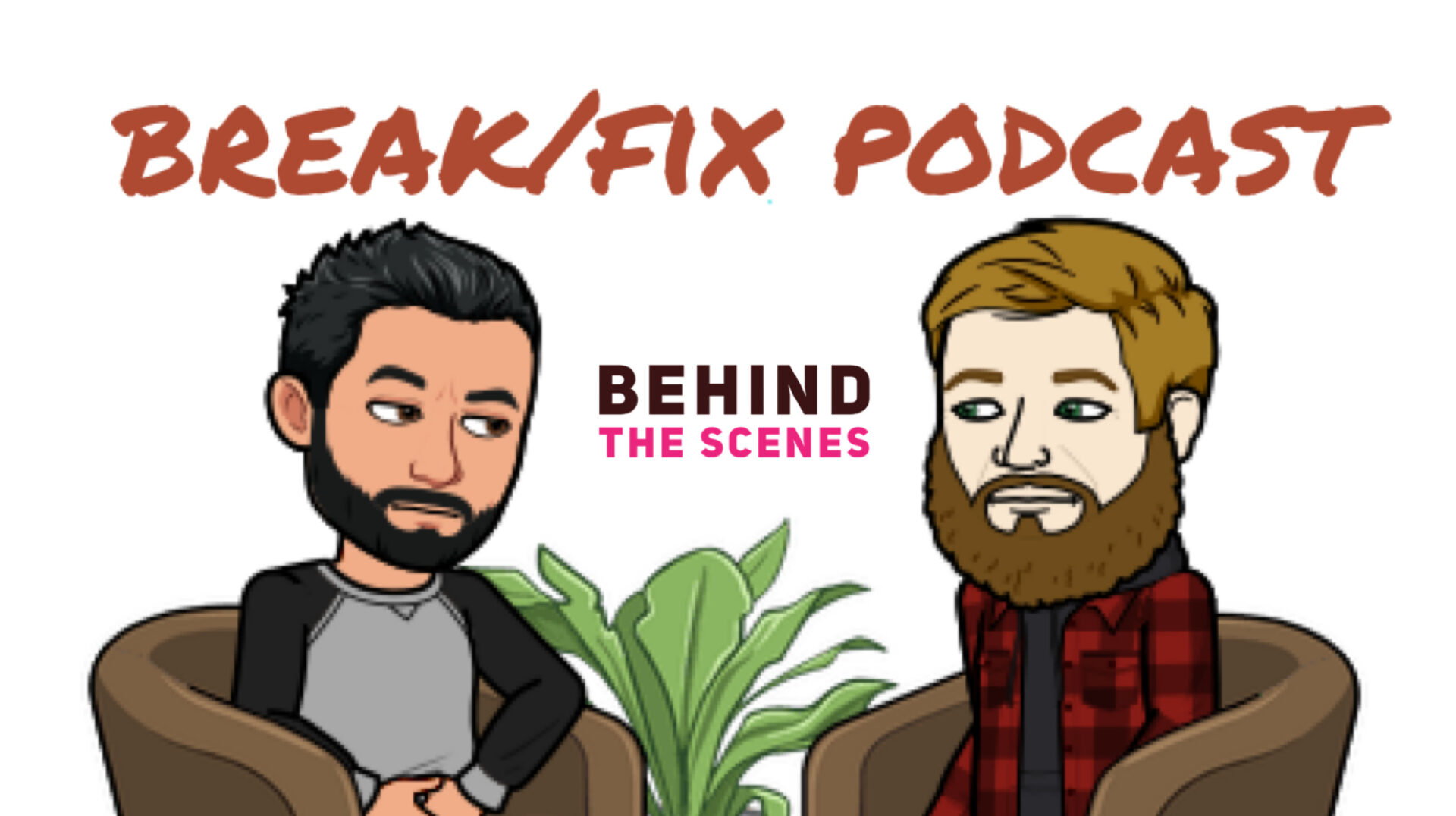
Consider becoming a GTM Patreon Supporter and get behind the scenes content and schwag!
Do you like what you've seen, heard and read? - Don't forget, GTM is fueled by volunteers and remains a no-annual-fee organization, but we still need help to pay to keep the lights on... For as little as $2.50/month you can help us keep the momentum going so we can continue to record, write, edit and broadcast your favorite content. Support GTM today! or make a One Time Donation.

If you enjoyed this episode, please go to Apple Podcasts and leave us a review. That would help us beat the algorithms and help spread the enthusiasm to others by way of Break/Fix and GTM. Subscribe to Break/Fix using your favorite Podcast App:
 |  |  |
In 1982, Bundy raced and won SCCA TransAm competition, in GTP driving the well-known group 44 Jaguar, in GTO with a Mustang, GTP Corvette, Showroom Stock, and has won Road Atlanta and Miami in a Lotus X180R. In 1992, Bundy was crowned Bridgestone Supercar Champion.
In the early 1990s, Bundy drove the Esprit X180R for Lotus as the team’s number one driver in IMSA’s Bridgestone Supercar Championship, winning the Driver’s Title and Manufacturer’s Championship for Lotus in 1992. Lotus teammates Andy Pilgrim and David Murry featured prominently in the standings, with additional varied drivers that included Paul Newman.
Bundy drove in the 1997 24 Hours of Le Mans in a David Price Racing Panoz Esperante GTR-1. He currently drives Lotus Elite, Lotus 23B, and 1978–79 John Player Special (Car #1) for Regogo Racing Team.
There's more to this story!
Be sure to check out the behind the scenes for this episode, filled with extras, bloopers, and other great moments not found in the final version. Become a Break/Fix VIP today by joining our Patreon.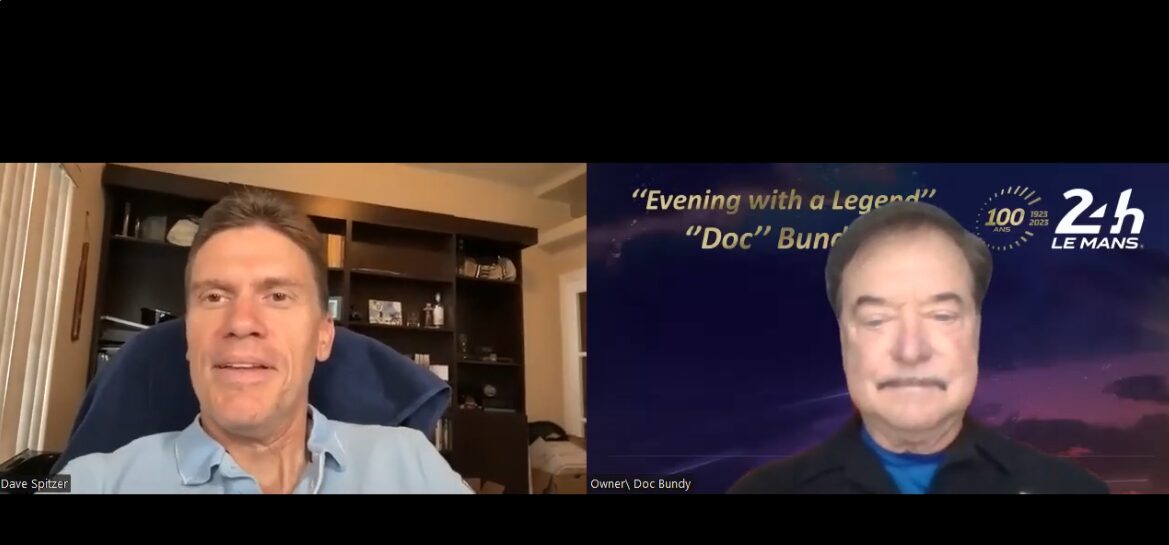
All of our BEHIND THE SCENES (BTS) Break/Fix episodes are raw and unedited, and expressly shared with the permission and consent of our guests.
We hope you enjoyed this presentation and look forward to more Evening With A Legend throughout this season. Sign up for the next EWAL TODAY!
Evening With A Legend (EWAL)
Evening With A Legend is a series of presentations exclusive to Legends of the famous 24 Hours of Le Mans giving us an opportunity to bring a piece of Le Mans to you. By sharing stories and highlights of the big event, you get a chance to become part of the Legend of Le Mans with guests from different eras of over 100 years of racing.
ACO USA
To learn more about or to become a member of the ACO USA, look no further than www.lemans.org, Click on English in the upper right corner and then click on the ACO members tab for Club Offers. Once you become a Member you can follow all the action on the Facebook group ACOUSAMembersClub; and become part of the Legend with future Evening With A Legend meet ups.



